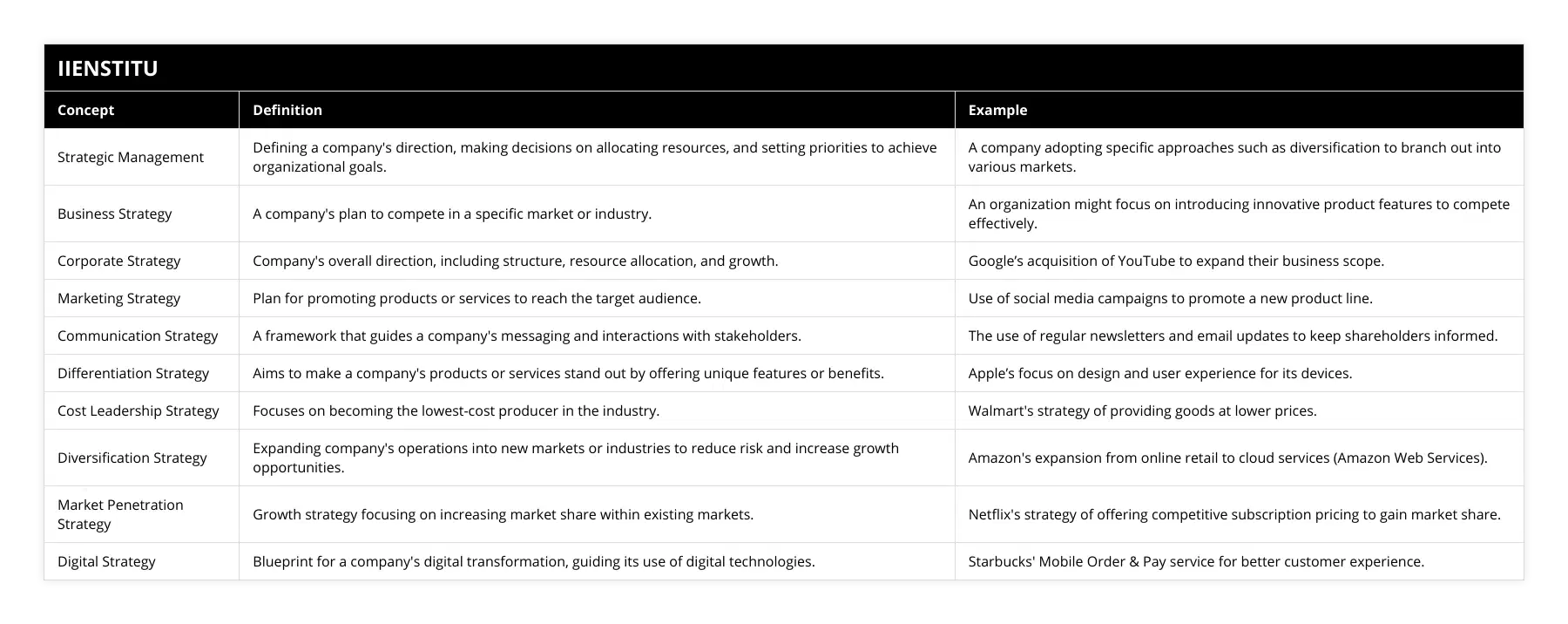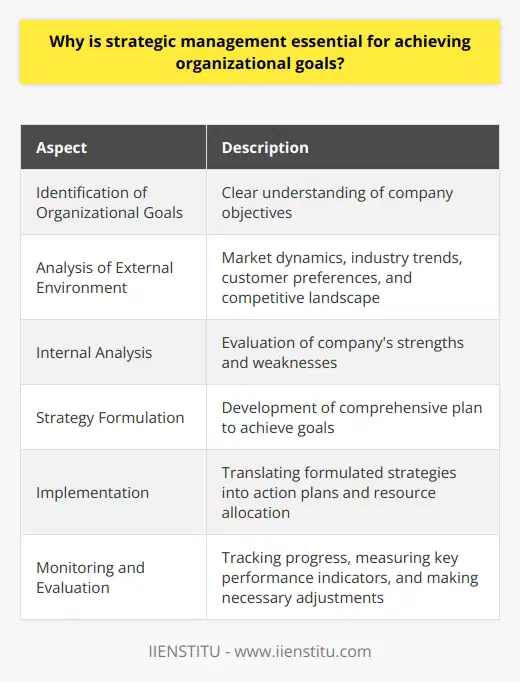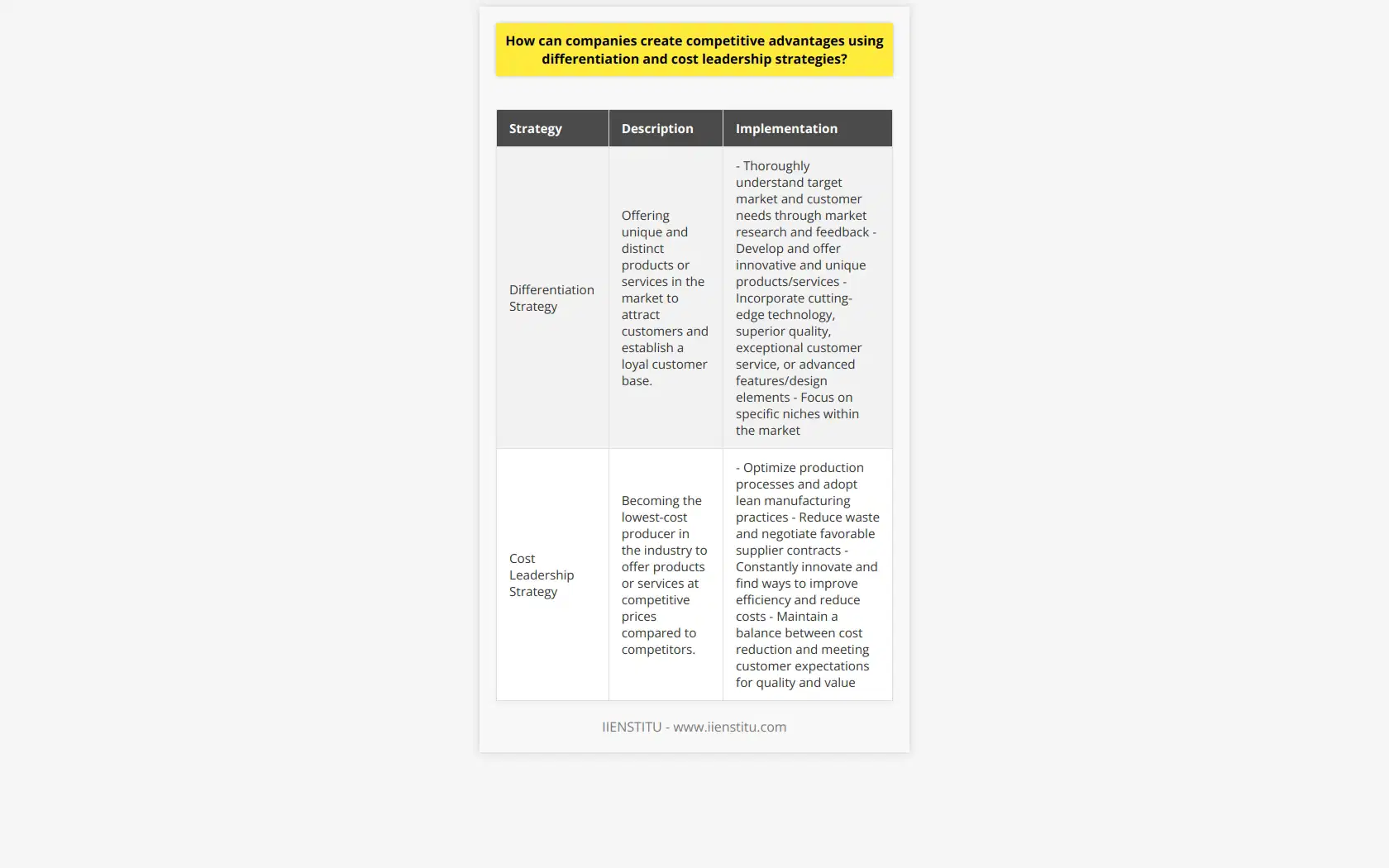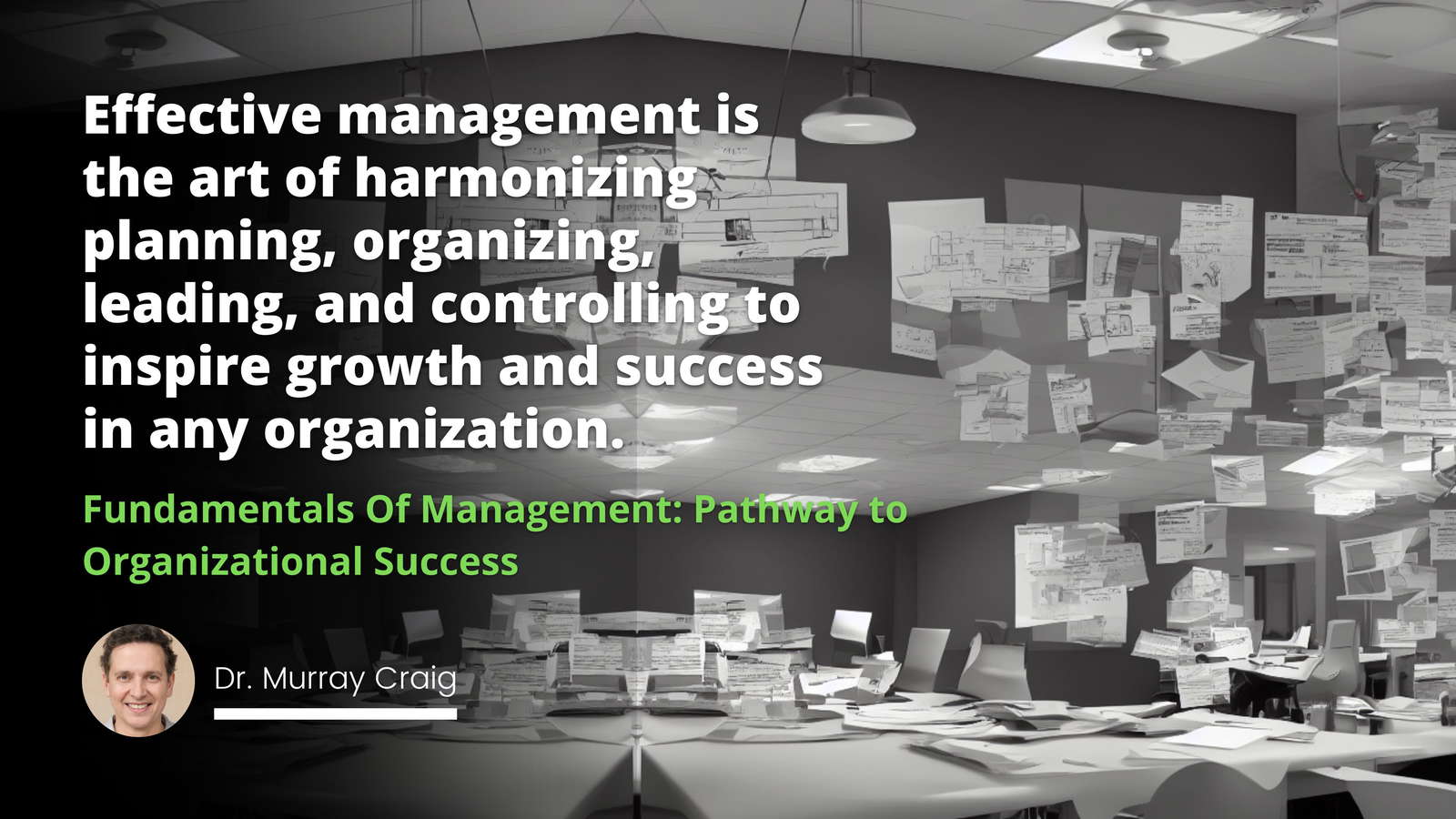
When I first stepped into the world of business, strategic management sounded like corporate jargon thrown around in boardrooms. But as I delved deeper into the fabric of successful organizations, I realized that strategies are not just plans on paper; they're the heartbeat of any thriving company. They're the compass that guides decision-making, the blueprint that molds actions, and the vision that fuels growth. Let's embark on a journey to unravel the essence of organizational goals and strategies, and see how they can transform a simple idea into a market-leading enterprise.
Embracing the Essence of Strategic Management
Imagine setting out on a road trip without a map or a destination in mind. Sounds chaotic, right? That's exactly how a business operates without a clear strategy. Strategic management is not just about setting goals; it's about crafting a path to achieve them while navigating through the competitive landscape.
Environmental scanning
Strategy formulation
Strategy implementation
Evaluation and Control
The Strategic Management Process: A Roadmap to Success
When I worked with a small startup a few years ago, we were overwhelmed by market complexities. But once we adopted a structured strategic management process, things started falling into place. This process typically involves:
1- Environmental Scanning: Just like checking the weather before heading out, businesses need to assess external and internal environments.
2- Strategy Formulation: Crafting plans based on insights gathered.
Vital Managerial Functions Roles İn Effective Management And Organizational Success
Most Searched Long Tail Keyword For Fundamentals Of Management And Its Functions
3- Strategy Implementation: Turning plans into actions.
4- Evaluation and Control: Monitoring progress and making necessary adjustments.
This iterative process ensures that organizations remain agile and responsive to changing market dynamics.
Differentiating Between Business and Corporate Strategies
At first glance, business strategy and corporate strategy might seem interchangeable. But understanding their nuances is crucial.
Business Strategy: Competing in the Marketplace
When my friend launched her artisanal coffee shop, she wasn't just selling coffee; she was selling an experience. Her business strategy focused on:
Product Differentiation: Offering unique coffee blends.
Market Penetration: Engaging local communities through events.
Positioning Strategy: Branding her shop as the go-to place for coffee enthusiasts.
Corporate Strategy: Steering the Ship
On the other hand, a corporate strategy is about the bigger picture. It's like a captain charting the course for an entire fleet. For larger organizations, this involves:
Resource Allocation: Deciding where to invest time and money.
Diversification: Expanding into new markets or products.
Acquisitions and Mergers: Growing the company through strategic partnerships.
A few years back, I observed how a local tech firm diversified into educational services, not by chance, but through a deliberate corporate strategy aiming for long-term growth.
The Harmonious Dance of Marketing and Communication Strategies
An organization's message must be clear and consistent. This is where marketing and communication strategies come into play.
Crafting an Impactful Marketing Strategy
When I was part of a team promoting an eco-friendly product line, we realized that our marketing strategy needed to resonate with environmentally conscious consumers. We focused on:
Highlighting the environmental benefits.
Engaging customers through social media campaigns.
Building brand awareness around sustainability.
Communication Strategy: The Voice of the Organization
But marketing isn't effective without a solid communication strategy. It's about ensuring that every message aligns with the company's values and goals. This includes:
Internal Communication: Keeping employees informed and engaged.
External Communication: Public relations, investor relations, and customer service.
A consistent communication strategy builds trust and strengthens the organization's brand image.
Building Competitive Advantages: Differentiation vs. Cost Leadership
In the bustling marketplace, standing out is essential. But the path to achieving this can vary.
Differentiation Strategy: Carving a Unique Space
One of my favorite examples is a boutique hotel I visited. Instead of competing with large chains, they offered personalized services, unique local experiences, and a homely ambiance. Their differentiation strategy centered on:
Unique Offerings: Local art in rooms, custom tour packages.
Exceptional Service: Staff knowing guests by name.
Cost Leadership Strategy: Winning Through Efficiency
Conversely, some businesses, like discount retailers, thrive by being the lowest-cost providers. Their cost leadership strategy focuses on:
Operational Efficiency: Streamlining processes to reduce costs.
Economies of Scale: Buying in bulk to lower expenses.
Technological Advancements: Automating tasks to save time and money.
By passing savings to customers, they capture a significant market share.
Exploring Growth Opportunities: Diversification and Market Penetration
Growth is the lifeline of any business, but how it's achieved can vary widely.
Diversification Strategy: Spreading the Wings
I recall a local bakery that started offering cooking classes. This diversification strategy not only opened a new revenue stream but also strengthened their brand. Diversification can be:
Horizontal: Adding related products or services.
Vertical: Controlling more of the supply chain.
Conglomerate: Venturing into entirely different industries.
Market Penetration Strategy: Deepening Market Presence
On the flip side, intensifying efforts in existing markets can yield significant growth. Strategies include:
Competitive Pricing: Offering discounts to attract more customers.
Enhanced Promotions: Loyalty programs or targeted advertising.
Product Improvements: Updating features to meet customer needs.
When a smartphone company launches frequent software updates, they're employing market penetration to increase user satisfaction and loyalty.
Success lies in strategic management.

Sailing into Uncharted Waters with the Blue Ocean Strategy
The Blue Ocean Strategy is all about innovation and creating uncontested market space.
I remember an entrepreneur who combined a gym with a co-working space. This unique blend attracted health-conscious professionals. By:
Creating New Demand: Offering services no one else did.
Breaking Trade-Offs: Combining leisure with work.
They tapped into a niche market, free from fierce competition.
The Digital Strategy Revolution
In today's digital age, integrating technology is not optional; it's essential.
The Role of Digital Strategy in Organizational Goals
A colleague revamped her traditional retail business by embracing an online human resources management certificate program, equipping herself with skills to manage her growing team remotely. Digital strategies involve:
Enhancing Customer Experience: Through apps or personalized online services.
Optimizing Operations: Using software for inventory or customer relations management.
Creating New Revenue Streams: E-commerce or digital products.
By adapting to digital trends, businesses can stay ahead of the curve and meet modern consumer expectations.
Cultivating Strategic Thinking: The Mindset for Success
Strategic thinking isn't just for top executives; it's a mindset that should permeate the entire organization.
The Importance of Strategic Thinking
When employees understand the bigger picture, they can make decisions that align with organizational goals. Encouraging strategic thinking leads to:
Innovation: Employees propose ideas that drive the company forward.
Proactive Problem-Solving: Anticipating challenges before they arise.
Continuous Improvement: Always seeking better ways to do things.
In a company I consulted for, fostering a culture of strategic thinking resulted in a significant boost in productivity and employee satisfaction.
Balancing Business-Level and Growth Strategies
Finding the equilibrium between maintaining current operations and pursuing growth is an art.
Integrating Business-Level Strategy with Growth Initiatives
A software company I knew maintained its core product (business-level strategy) while exploring new applications for different industries (growth strategy). Balancing these ensures:
Sustained Competitive Advantage: Continuing to excel in the core market.
Opportunity Exploration: Venturing into new markets without neglecting the existing one.
The Power of Strategic Analysis
Regularly reviewing strategies keeps a business aligned with its goals.
Conducting Effective Strategic Analysis
Using tools like SWOT analysis, businesses can:
Identify Strengths and Weaknesses: Internal factors affecting performance.
Spot Opportunities and Threats: External factors in the market.
This proactive approach enables organizations to adapt swiftly and stay competitive.
Conclusion: The Journey Towards Organizational Excellence
Reflecting on my experiences, one thing stands clear: success lies in strategic management. It's not about having the most resources or the best product; it's about making informed decisions, adapting to change, and aligning every action with the overarching goals. Whether you're a budding entrepreneur or part of a multinational corporation, embracing strategic principles can propel you toward unprecedented success.
References
1- Porter, M. E. (1985). Competitive Advantage: Creating and Sustaining Superior Performance. New York: Free Press.
2- Kaplan, R. S., & Norton, D. P. (1996). The Balanced Scorecard: Translating Strategy into Action. Boston: Harvard Business School Press.
3- Kim, W. C., & Mauborgne, R. (2005). Blue Ocean Strategy: How to Create Uncontested Market Space and Make the Competition Irrelevant. Boston: Harvard Business School Press.
4- Mintzberg, H. (1994). The Rise and Fall of Strategic Planning. New York: Free Press.
5- Johnson, G., Scholes, K., & Whittington, R. (2008). Exploring Corporate Strategy. Harlow: Pearson Education Limited.
6- Ansoff, H. I. (1965). Corporate Strategy: An Analytic Approach to Business Policy for Growth and Expansion. New York: McGraw-Hill.
Frequently Asked Questions
Why is strategic management essential for achieving organizational goals?
Strategic management helps align company objectives with the external environment and competitive landscape, ensuring that resources are allocated effectively to achieve organizational goals.

What are the key components of a successful business strategy?
A successful business strategy includes market penetration, product differentiation, and positioning, which help create and deliver customer value.
How can companies create competitive advantages using differentiation and cost leadership strategies?
Companies can create competitive advantages by offering unique products or services (differentiation strategy) or becoming the industry's lowest-cost producer (cost leadership strategy). These approaches enable companies to stand out from their competitors and attract customers.



